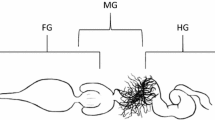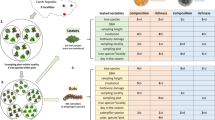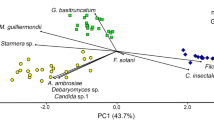Abstract
The Antarctic mite (Alaskozetes antarcticus) is widely distributed on sub-Antarctic islands and throughout the Antarctic Peninsula, making it one of the most abundant terrestrial arthropods in the region. Despite the impressive ability of A. antarcticus to thrive in harsh Antarctic conditions, little is known about the biology of this species. In this study, we performed 16S rRNA gene sequencing to examine the microbiome of the final immature instar (tritonymph) and both male and female adults. The microbiome included a limited number of microbial classes and genera, with few differences in community membership noted among the different stages. However, the abundances of taxa that composed the microbial community differed between adults and tritonymphs. Five classes—Actinobacteria, Flavobacteriia, Sphingobacteriia, Gammaproteobacteria, and Betaproteobacteria—comprised ~ 82.0% of the microbial composition, and five (identified) genera—Dermacoccus, Pedobacter, Chryseobacterium, Pseudomonas, and Flavobacterium—accounted for ~ 68.0% of the total composition. The core microbiome present in all surveyed A. antarcticus was dominated by the families Flavobacteriaceae, Comamonadaceae, Sphingobacteriaceae, Chitinophagaceae and Cytophagaceae, but the majority of the core consisted of operational taxonomic units of low abundance. This comprehensive analysis reveals a diverse microbiome among individuals of different stages, with overlap likely due to their shared habitat and common feeding preferences as herbivores and detritivores. The microbiome of the Antarctic mite shows considerably more diversity than observed in mite species from lower latitudes.






Similar content being viewed by others
References
Afgan E, Baker D, Batut B, van den Beek M, Bouvier D, Čech M, Chilton M, Clements D, Coraor N, Grüning B, Guerler A, Hillman-Jackson J, Jalili V, Rasche H, Soranzo N, Goecks J, Taylor J, Nekrutenko A, Blankenberg D (2018) The Galaxy platform for accessible, reproducible and collaborative biomedical analyses: 2018 update. Nucleic Acids Res 46:W537–W544
Aislabie J, Jordan S, Barker G (2008) Relation between soil classification and bacterial diversity in soils of the Ross Sea region, Antarctica. Geoderma 144:9–20
Apprill A, McNally S, Parsons R, Weber L (2015) Minor revision to V4 region SSU rRNA 806R gene primer greatly increases detection of SAR11 bacterioplankton. Aquat Microb Ecol 75:129–137
Bahrndorff S, de Jonge N, Hansen JK, Lauritzen JMS, Spanggaard LH, Sørensen MH, Yde M, Nielsen JL (2018) Diversity and metabolic potential of the microbiota associated with a soil arthropod. Sci Rep 8:2491
Bej AK, Saul D, Aislabie J (2000) Cold-tolerant alkane-degrading Rhodococcus species from Antarctica. Polar Biol 23:100–105
Benoit JB, Yoder JA, Lopez-Martinez G, Elnitsky MA, Lee RE Jr, Denlinger DL (2008) Adaptations for the maintenance of water balance by three species of Antarctic mites. Polar Biol 31:539–547
Bernardet JF, Segers P, Vancanneyt M, Berthe F, Kersters K, Vandamme P (1996) Cutting a Gordian knot: emended classification and description of the genus Flavobacterium, emended description of the family Flavobacteriaceae, and proposal of Flavobacterium hydatis nom. nov. (basonym, Cytophaga aquatilis Strohl and Tait 1978). Int J Syst Evolut Microbiol 46:128–148
Block W, Convey P (1995) The biology, life cycle and ecophysiology of the Antarctic mite Alaskozetes antarcticus. J Zool 236:431–449
Bokhorst S, Convey P (2016) Impact of marine vertebrates on Antarctic terrestrial micro-arthropods. Antarct Sci 28:175–186
Caporaso JG, Lauber CL, Walters WA, Berg-Lyons D, Lozupone CA, Turnbaugh PJ, Fierer N, Knight R (2011) Global patterns of 16S rRNA diversity at a depth of millions of sequences per sample. Proc Natl Acad Sci 108:4516–4522
Chan TF, Ji KM, Yim AKY, Liu XY, Zhou JW, Li RQ, Yang KY, Li J, Li M, Law PTW (2015) The draft genome, transcriptome, and microbiome of Dermatophagoides farinae reveal a broad spectrum of dust mite allergens. J Allergy Clin Immunol 135:539–548
Chen B (2018) VennDiagram: generate high-resolution Venn and Euler plots. R package version 1.6.20
Convey P (1994a) Growth and survival strategy of the Antarctic mite Alaskozetes antarcticus. Ecography 17:97–107
Convey P (1994b) Sex ratio, oviposition and early development of the Antarctic oribatid mite Alaskozetes antarcticus (Acari: Cryptostigmata) with observations on other oribatids. Pedobiologia 2:161–168
De Meillon B, Golberg L (1946) Preliminary studies on the nutritional requirements of the bed bug (Cimex lectularius L.) and the tick Ornithodorus moubata Murray. J Exp Biol 24:41–63
Díaz S, Villavicencio B, Correia N, Costa J, Haag KL (2016) Triatomine bugs, their microbiota and Trypanosoma cruzi: asymmetric responses of bacteria to an infected blood meal. Parasites Vectors 9:636
Dragulescu A (2014) xlsx: read, write, formal Excel 2007 and Excel 97/2000/xp/2003 files. R package version 04 2
Edgar RC, Haas BJ, Clemente JC, Quince C, Knight R (2011) UCHIME improves sensitivity and speed of chimera detection. Bioinformatics 27:2194–2200
Erban T, Ledvinka O, Nesvorna M, Hubert J (2017) Experimental manipulation shows a greater influence of population than dietary perturbation on the microbiome of Tyrophagus putrescentiae. Appl Environ Microbiol 83:e00128–e217
Everatt M, Convey P, Worland M, Bale J, Hayward S (2013) Heat tolerance and physiological plasticity in the Antarctic collembolan, Cryptopygus antarcticus, and mite, Alaskozetes antarcticus. J Therm Biol 38:264–271
Fagen JR, Giongo A, Brown CT, Davis-Richardson AG, Gano KA, Triplett EW (2012) Characterization of the relative abundance of the citrus pathogen Ca. Liberibacter asiaticus in the microbiome of its insect vector, Diaphorina citri, using high throughput 16S rRNA sequencing. Open Microbiol J 6:29
Fox J, Weisberg S (2011) Car: companion to applied regression. https://www.CRAN. R-project org/package= car
Fuka MM, Wallisch S, Engel M, Welzl G, Havranek J et al (2013) Dynamics of bacterial communities during the ripening process of different croatian cheese types derived from raw Ewe's milk cheeses. PLoS ONE 8:e80734
Gong X, Chen TW, Zieger SL, Bluhm C, Heidemann K, Schaefer I, Maraun M, Liu M, Scheu S (2018) Phylogenetic and trophic determinants of gut microbiota in soil oribatid mites. Soil Biol Biochem 123:155–164
Graves S, Piepho HP, Selzer, ML (2015) Package ‘multcompView’
Greer C, Whyte L, Niederberger T (2010) Microbial communities in hydrocarbon-contaminated temperate, tropical, alpine, and polar soils. In: Timmis KN (ed) Handbook of hydrocarbon and lipid microbiology. Springer, Berlin, pp 2313–2328
Haeder S, Wirth R, Herz H, Spiteller D (2009) Candicidin-producing Streptomyces support leaf-cutting ants to protect their fungus garden against the pathogenic fungus Escovopsis. Proc Natl Acad Sci 106:4742–4746
Herrera LM, García-Laviña CX, Marizcurrena JJ, Volonterio O, de León RP, Castro-Sowinski S (2017) Hydrolytic enzyme-producing microbes in the Antarctic oligochaete Grania sp. (Annelida). Polar Biol 40:947–953
Hilgenboecker K, Hammerstein P, Schlattmann P, Telschow A, Werren JH (2008) How many species are infected with Wolbachia?—a statistical analysis of current data. FEMS Microbiol Lett 281:215–220
Hope R (2013) Rmisc: Ryan miscellaneous. R package version 1.
Hubert J, Kopecky J, Sagova-Mareckova M, Nesvorna M, Zurek L, Erban T (2016) Assessment of bacterial communities in thirteen species of laboratory-cultured domestic mites (Acari: Acaridida). J Econ Entomol 109:1887–1896
Hubert J, Erban T, Kopecky J, Sopko B, Nesvorna M, Lichovnikova M, Schicht S, Strube C, Sparagano O (2017) Comparison of microbiomes between red poultry mite populations (Dermanyssus gallinae): predominance of Bartonella-like bacteria. Microb Ecol 74:947–960
Hubert J, Nesvorna M, Sopko B, Smrz J, Klimov P, Erban T (2018) Two populations of mites (Tyrophagus putrescentiae) differ in response to feeding on feces-containing diets. Front Microbiol 9:2590
Joern A, Behmer ST (1997) Importance of dietary nitrogen and carbohydrates to survival, growth, and reproduction in adults of the grasshopper Ageneotettix deorum (Orthoptera: Acrididae). Oecologia 112:201–208
Kozich JJ, Westcott SL, Baxter NT, Highlander SK, Schloss PD (2013) Development of a dual-index sequencing strategy and curation pipeline for analyzing amplicon sequence data on the MiSeq Illumina sequencing platform. Appl Environ Microbiol 79:5112–5120
Lenth RV (2016) Least-squares means: the R package lsmeans. J Stat Softw 69:1–33
López-García A, Pineda-Quiroga C, Atxaerandio R, Pérez A, Hernández I, García-Rodríguez A, González-Recio O (2018) Comparison of mothur and QIIME for the analysis of rumen microbiota composition based on 16S rRNA amplicon sequences. Front Microbiol 9:1–11
Mangiafico S (2015) An R companion for the handbook of biological statistics, version 1.09 i.
Moquin S, Garcia J, Brantley S, Takacs-Vesbach C, Shepherd U (2012) Bacterial diversity of bryophyte-dominant biological soil crusts and associated mites. J Arid Environ 87:110–117
Narasimhan S, Fikrig E (2015) Tick microbiome: the force within. Trends Parasitol 31:315–323
Nielsen UN, Osler GH, Campbell CD, Burslem DF, van der Wal R (2012) Predictors of fine-scale spatial variation in soil mite and microbe community composition differ between biotic groups and habitats. Pedobiologia 55:83–91
Ondov BD, Berqman NH, Phillippy AM (2011) Interactive metagenomic visualization in a Web browser. BMC Bioinform 12:385
Pakwan C, Kaltenpoth M, Weiss B, Chantawannakul P, Jun G, Disayathanoowat T (2017) Bacterial communities associated with the ectoparasitic mites Varroa destructor and Tropilaelaps mercedesae of the honey bee (Apis mellifera). FEMS Microbiol Ecol 93:160
Pathom-Aree W, Stach JE, Ward AC, Horikoshi K, Bull AT, Goodfellow M (2006) Diversity of actinomycetes isolated from challenger deep sediment (10,898 m) from the Mariana Trench. Extremophiles 10:181–189
Pekas A, Palevsky E, Sumner JC, Perotti MA, Nesvorna M, Hubert J (2017) Comparison of bacterial microbiota of the predatory mite Neoseiulus cucumeris (Acari: Phytoseiidae) and its factitious prey Tyrophagus putrescentiae (Acari: Acaridae). Sci Rep 7:2
Radwan S (2008) Microbiology of oil-contaminated desert soils and coastal areas in the Arabian Gulf region. In: Dion P, Nautiyal CS (eds) Microbiology of extreme soils. Springer, Berlin, pp 275–298
Rainey FA, Ray K, Ferreira M, Gatz BZ, Nobre MF, Bagaley D, Rash BA, Park MJ, Earl AM, Shank NC (2005) Extensive diversity of ionizing-radiation-resistant bacteria recovered from Sonoran Desert soil and description of nine new species of the genus Deinococcus obtained from a single soil sample. Appl Environ Microbiol 71:5225–5235
Ruckmani A, Kaur I, Schumann P, Klenk HP, Mayilraj S (2011) Calidifontibacter indicus gen. nov., sp. nov., a member of the family Dermacoccaceae isolated from a hot spring, and emended description of the family Dermacoccaceae. Int J Syst Evol Microbiol 61:2419–2424
Schloss PD, Westcott SL, Ryabin T, Hall JR, Hartmann M, Hollister EB, Lesniewski RA, Oakley BB, Parks DH, Robinson CJ (2009) Introducing mothur: open-source, platform-independent, community-supported software for describing and comparing microbial communities. Appl Environ Microbiol 75:7537–7541
Schuler CG, Havig JR, Hamilton TL (2017) Hot spring microbial community composition, morphology, and carbon fixation: implications for interpreting the ancient rock record. Front Earth Sci 5:97
Shimada K, Pan C, Ohyama Y (1992) Variation in summer cold-hardiness of the Antarctic oribatid mite Alaskozetes antarcticus from contrasting habitats on King George Island. Polar Biol 12:701–706
Stackebrandt E, Schumann P (2014) The family Dermacoccaceae. In: Rosenberg E, DeLong EF, Lory S, Stackebrandt E, Thompson F (eds) The prokaryotes. Springer, Berlin, pp 301–315
Swei A, Kwan JY (2017) Tick microbiome and pathogen acquisition altered by host blood meal. ISME J 11:813
Van Borm S, Buschinger A, Boomsma JJ, Billen J (2002) Tetraponera ants have gut symbionts related to nitrogen–fixing root–nodule bacteria. Proc R Soc Lond B 269:2023–2027
Webster NS, Negri AP, Munro MM, Battershill CN (2004) Diverse microbial communities inhabit Antarctic sponges. Environ Microbiol 6:288–300
Wickham H (2007) Reshaping data with the reshape Package. J Stat Softw 21:1–20
Wickham H (2009) ggplot2: elegant graphics for data analysis
Wickham H, Francois R, Henry L, Müller K (2017) dplyr: a grammar of data manipulation. R package version 0.7.4
Worland MR, Lukešová A (2000) The effect of feeding on specific soil algae on the cold-hardiness of two Antarctic micro-arthropods (Alaskozetes antarcticus and Cryptopygus antarcticus). Polar Biol 23:766–774
Yang YW et al (2015) Use of 16S rRNA gene-targeted group-specific primers for real-time PCR analysis of predominant bacteria in mouse feces. Appl Environ Microbiol 81:6749–6756
Yang B, Wang Y, Qian PY (2016) Sensitivity and correlation of hypervariable regions in 16S rRNA genes in phylogenetic analysis. BMC Bioinform 17:135
Young S, Block W (1980) Experimental studies on the cold tolerance of Alaskozetes antarcticus. J Insect Physiol 26:189–200
Zindel R, Ofek M, Minz D, Palevsky E, Zchori-Fein E, Aebi A (2013) The role of the bacterial community in the nutritional ecology of the bulb mite Rhizoglyphus robini (Acari: Astigmata: Acaridae). FASEB J 27:1488–1497
Zolnik CP, Prill RJ, Falco RC, Daniels TJ, Kolokotronis SO (2016) Microbiome changes through ontogeny of a tick pathogen vector. Mol Ecol 25:4963–4977
Acknowledgements
This research was supported by the National Science Foundation (NSF PLR 1341385 and NSF PLR 1341393, with partial support for computing resources in DEB-1654417). This study used the Nephele platform from the National Institute of Allergy and Infectious Diseases (NIAID) Office of Cyber Infrastructure and Computational Biology (OCICB) in Bethesda, MD. We are grateful for the hard work and assistance of the support staff at Palmer Station.
Author information
Authors and Affiliations
Corresponding author
Ethics declarations
Conflict of interest
The authors declare no conflict of interest.
Additional information
Publisher's Note
Springer Nature remains neutral with regard to jurisdictional claims in published maps and institutional affiliations.
Electronic supplementary material
Below is the link to the electronic supplementary material.
Rights and permissions
About this article
Cite this article
Holmes, C.J., Jennings, E.C., Gantz, J.D. et al. The Antarctic mite, Alaskozetes antarcticus, shares bacterial microbiome community membership but not abundance between adults and tritonymphs. Polar Biol 42, 2075–2085 (2019). https://doi.org/10.1007/s00300-019-02582-5
Received:
Revised:
Accepted:
Published:
Issue Date:
DOI: https://doi.org/10.1007/s00300-019-02582-5




